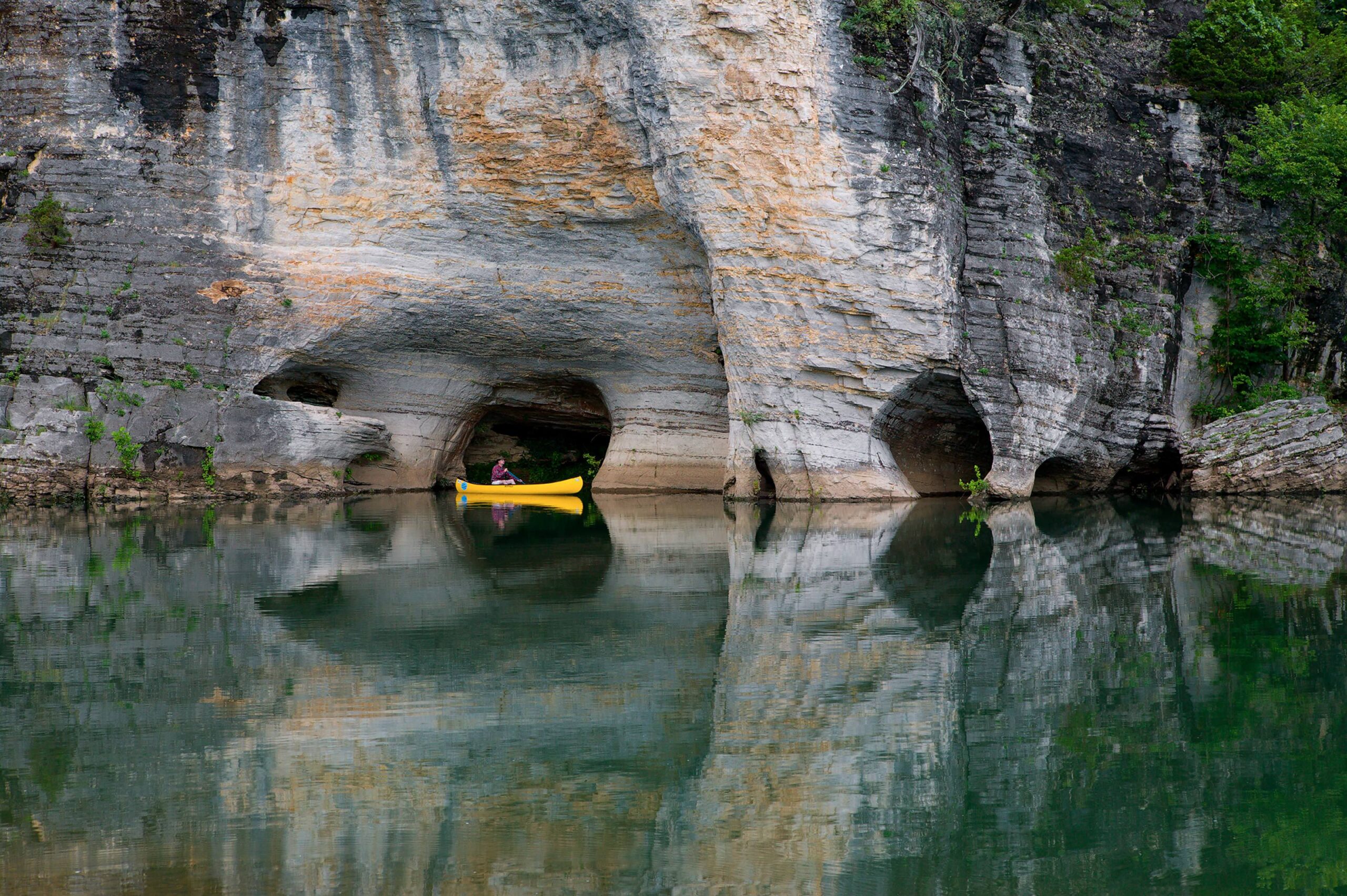Winding down the mountain and through the rugged landscape of dense forest scattered with enormous rock formations, the road flattens out at the tiny, outdoor town of Ponca, Arkansas. With a population of fewer than 120 people, a post office, and a couple of wilderness outfitting stores, Ponca is the middle of nature-nowhere for the Midwest. With stunningly beautiful rustic surroundings and a full array of outdoor adventure opportunities, this northern Arkansas area is perhaps one of America’s best-kept secrets.
Ponca rests on the Buffalo River, the first river in America to be designated a National River. Commencing deep in the highest elevations of the Boston Mountains, the river’s over 150 miles of winding water carve a path eastward through the wilds and wonders of northern Arkansas. Its uppermost section boasts such steep terrain, sharp ridges, crags, and crevices that roughly the first 16 miles are further designated as wild, and the upstream gem is officially known as the Buffalo National Wild and Scenic River.
Show up at the Ponca Low-Water Bridge on any spring weekend morning, and you’re likely to see groups of people wearing orange life vests, paddles in hand, shoving off from shore in canoes bearing outfitters’ logos. Across the bridge lies a short trail to a historic cabin built in 1882, as well as a trailhead leading to a scenic, full-day, 12-mile hike upstream to Boxley—a small community in times past but now a river put-in and trailhead itself. Beneath this hiking stretch, the valley extending up to the ridgetops is a favorite location for Arkansas’s only herd of wild elk. Catching sight of them grazing before a backdrop of sloping terrain near the river’s emerald green waters resembles a scene from somewhere out West.
History
The Buffalo National River was established in 1972; its founding was the result of a long, contentious battle that began in 1960 when the U.S. Army Corps of Engineers proposed the construction of two hydroelectric dams that would have destroyed the river and buried its beauties. Under the leadership of Dr. Neil Compton, area residents and outdoor enthusiasts united to fight the proposal, forming a coalition known as the Ozark Society. Their decade of unwavering commitment to the river’s preservation ultimately saved the Buffalo and the treasured wilderness surrounding it.

The year 2022 marks the 50th anniversary of the Buffalo as a nationally protected area.
One of the few remaining free-flowing rivers left in the lower half of the country, the Buffalo River itself is a sculpted work of art, with water carving around rock and winding through untouched stretches of Arkansas wilderness. Its towering, seemingly painted bluffs are striking, and the clear emerald water that runs beneath them, vibrant and pristine. The waterway is a mecca for canoeists, kayakers, fly-fishers, and riverside campers. Perhaps an even greater set of wilderness wonders, however, exists within the surrounding crags, cliffs, and creeks beyond its banks—discoveries found after setting out with a pair of hiking boots, a map, and a backpack.
Area hiking expert Tim Ernst has spent almost a lifetime unveiling some of those discoveries, carving out trails, and documenting many of the Buffalo Wilderness Area’s wonders. His journaled publications are vital to hikers and backpackers alike, as they record miles of hiking trails ranging from the frequently traveled to the obscure, the relaxing stroll to the arduous climb, and the tiny trail to the week-long expedition.
Buffalo Wilderness Area
The nearly 95,000 acres encompassing the Buffalo National River hold a network of trails and treasures that extends even farther as it connects with the surrounding 1.2 million acres of rugged Ozark National Forest. With levels of exploration ranging from novice to hard-core hiking, and opportunities for mountain biking and equestrianism as well, the undeveloped remote areas are full of treasures waiting to be discovered by outdoor enthusiasts of all levels and ages.
Hiking the Buffalo Wilderness Area is also year-round. “You can’t hike in the Rockies, the Appalachians, or the Pacific Crest in the middle of winter,” said Ernst, “but you can hike in northern Arkansas—and the Buffalo’s emerald-colored water contrasted with scenic views of grays and browns is striking.”
Just this past January, Ernst completed an end-to-end winter bushwhacking journey starting at the river’s Cave Mountain headwaters and traveling 151 miles down to the mouth at the White River. A spinal issue prevents him from carrying a pack, so he completed the two-week excursion tentless and stoveless, sleeping under bluff overhangs and traveling ultra-light. “It was one of the most fun and spectacular trips I’ve ever taken,” he said.
Day Hiking Discoveries
You don’t need to sleep under a rock in winter to see some of the best of what the Buffalo River’s wilderness areas have to offer. Although there are plenty of single-track trails for backpackers and serious trekkers, easier trails with amazing sights and abundant waterfalls are not far from the pavement (or gravel, in this case).

Lost Valley is one of those signature trails, with everything from vertical walls of rock reaching upward from the valley floor, to Cob Cave—named after the many cobs of corn discovered there in 1931 when it was found to be rich in preserved native artifacts. Following Clark Creek, Lost Valley’s beauty is on display throughout the entire hike, winding through a lush forest full of waterfalls, cascades, and amazing rock formations. Packed with outdoor works of art and springtime wildflowers, the short, two-mile round trip is a scenic journey from start to finish and a small taste of the entire Buffalo River area.
Another offering among the renowned trails and signature sights is Hemmed-in Hollow, a towering waterfall and impressive rock formation that spills out varied amounts of water or displays icicles, depending on the season. A more arduous trail with a 1,400-foot elevation change, it isn’t for the faint of heart. Those up for the challenge will not be disappointed, though, as the famed, 209-foot vertical rock face is the tallest waterfall between the Rockies and the Appalachians, and hiking to its base is like discovering a secret hideaway at the end of a canyon.
Nearby lies another geological wonder that, when first encountered, might feel like a sacred discovery as well. Big Bluff, accessible via the appropriately named Goat Trail, is an impressive, oversized rock face, leaning out over the river with breathtaking views. Wrapping around the mountain and morphing into a mammoth wall of sandstone, the somewhat precarious trail narrows to curve around the bluff, revealing a 550-foot drop and an expansive view of the river and backcountry below.
Backcountry and Dark Skies
Lost Valley, Hemmed-in Hollow, and Big Bluff are just a few of the amazing trails and seemingly endless sights for day hikers to explore. On the other hand, hikers preferring to gear up with backpacks and tents for a weekend or two, venturing off the beaten path in the woods, can find what they’re after on the Buffalo River Trail. Winding back and forth across the river, as well as up and down in elevation, the “BRT,” as it’s known, totals almost 80 miles in length and can take you downstream via foot rather than canoe. Eventually connecting with the almost 200-mile network of the rugged and remote Ozark Highlands Trail, the Buffalo backcountry feels endless—ideal for trekking each day and sleeping under the stars each night.
Speaking of stars, the Buffalo National River was recognized in 2019 as an International Dark Sky Park. With the darkest nighttime skies in all of Arkansas, the park is a great place to go to escape suburbia and do some stargazing, learn the constellations, or see the Milky Way. With park regulations aimed at eliminating light pollution, the natural twinkling lights of nighttime skies are now as protected as the wilderness they blanket.

Preservation Through Growth
Many historical cabins and preserved homesteads are scattered throughout the Buffalo area as well. Granny Henderson’s cabin, the Parker-Hickman Farmstead in nearby Erbie, and the Villines family cabins in Ponca all commemorate a past era when pioneers worked tirelessly to survive in the wilds of a rugged landscape while carving out hard livings.
Although times have greatly changed since those days, the raw, rustic, and simplistic form of much of the area is still preserved. In the past 50 years in particular, since the national park and national river were established, the town of Ponca and the Boxley River Valley have remained virtually unchanged. Nestled in the valley between mountainside and river, the old-school mountain town atmosphere is difficult to miss.
The Buffalo Outdoor Center outfitters and Lost Valley Canoe and Lodging rentals still reside as the only two businesses of tiny Ponca, and most of the cabins viewed from the road are rentals. There are no motels. Although certainly adding to the area’s charm, the simplicity also poses some issues during crowded times, especially as the area grows in popularity.
“Elk, waterfalls, and hiking trails have increased traffic to the Buffalo River immensely,” said Ernst. “Particularly when the big bulls are out there bugling.”
The once-unknown, tiny area’s increased popularity hints at the need for new infrastructure to handle it—apparently, grants are in place to do just that. In the meantime, though, this area is still “in its infancy,” as Ernst said, citing that there aren’t too many places left in the United States where you can still chart new territory as a hiker or backpack a 47-mile section of backcountry without any established campsites.
Labeled the “Natural State” for a reason, Arkansas has plenty of raw, rare, hidden beauty, and although it’s rapidly growing, the Buffalo River remains a somewhat unrecognized outdoor mecca. “I doubt that the personal experience of discovery will ever be completed here,” Ernst challenged. So next time you’re in search of adventure, find Arkansas Highway 43 on a map, head south, and wind down into Newton County, stopping off in Ponca. A bit like venturing off the grid, the disconnection from your everyday world may end up connecting you with exactly what you’ve been looking for.
This article was originally published in American Essence magazine.













